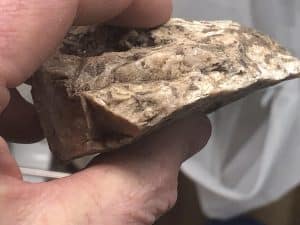Your Happy Place and Refuge.
Adventures in your own back yard.
As I drive around the lake in my community I come across some new development.
It appears to be a great new addition to our community, a bath house and restrooms located at a place called Slater Park.
Slater Parks has always held my imagination because it is a natural peninsula.
It has always been a park or a place of higher value because of its position in relationship to the lake.
It is cooler in the summer having water on three sides, any wind or breeze keeps the mosquitoes away.
I suspect it was used as a pleasant spot to reside long before settlers arrived one hundred and fifty years ago.
Because of the new addition in Slater Park I’m able to see a bit of the stratigraphy of the soil and kick around in the dirt piles that have yet to be leveled off into a neat and finished landscape.
There has been significant rains so the soil has been washed and all of the rocky debris in the soil has been revealed.
Twenty yards into my stroll I spot a piece of Pipestone.
It has been crudely, very crudely shaped into an arrowhead shape, it also has a hole that appears to be for a pendant.
This first find is odd because it is not material that a native American would use to make an arrowhead.
It is odd because it appears that no metal object (drill or saw) was used to create this object, the hole is irregular and the sides seem to be scraped into shape and form.
I have reason to believe that we’ve found an artifact of some of the original inhabitants of this delightful peninsula we call Slater Park.
The stone itself came from the Pipestone Quarries that are about 65 miles distant.
The sacred quarries were shared by various Siouan tribes in this region, Dakota, Oto? Kansa?, Osage? Iowa?
The stone in which Pipestone is found is called Morton Gneiss commonly know as Sioux Quartzite.
This Sioux Quartzite number nine on the Moes Scale. (It is really hard!) so extracting the Pipestone is a labor intensive enterprise.
In approximately the 1870’s to 90’s it was taken over by early pioneers.
The pioneers took this sacred stone and fashioned, carved and shaped Bibles and various artifacts, replicating tomahawks , arrowhead shapes and other kitsch items.
This was the first souvenir stand in the midwest.
My Pipestone find is not diagnostic and I can’t determine who made it.
I can only say with some certainty that it was not made with anything iron or steel.
Perhaps we can assume it is made by a child of a pioneer or else a Native American child.
I walk another thirty yards and pick up what appear to be a chert like stone and as I turn it over it reveals itself.
It has a half dozen percussion marks and is clearly a scraper for animal hides.
More importantly and significantly is that it is large, very large for a scraper.
Most scrapers are 1/2 inch to 1 inch in length. This scraper is 3 1/2 inches in length and an inch thick, it appears not to be held between the fingers, because of its length and size it would appear to certainly be held in the palm of our hand.
This was the scraper for large animal skins, deer or bison, or perhaps mega fauna? Short Faced Bears? Dire wolves? etc.
Five steps further I pick up another piece of flint.
It is a bifacial blade of some sort. It is a tool that cuts through hides. It also reflects the limited resource within my region.
Most of the “flint” artifacts are made of material that are of marginal quality, we live in a “chert poor” region.
Every time I pick up an arrowhead I dwell on the fact that this was the material with which they had to work, rather poor quality.
Life wasn’t easy when your sticks weren’t that pointy and sharp.
These artifacts confirm my suspicion that this is certainly a camp site of Native Americans.
They enjoyed this place when buffalo roamed, they enjoyed this place when the short faced bear was your worst night mare.
They enjoyed the westerly breezes off the lake that would keep the mosquitoes at bay.
You too can enjoy their park along with the modern conveniences of bathrooms and bath houses.
Compliments of the City of Worthington and our Native Ancestors.
Bill Keitel



